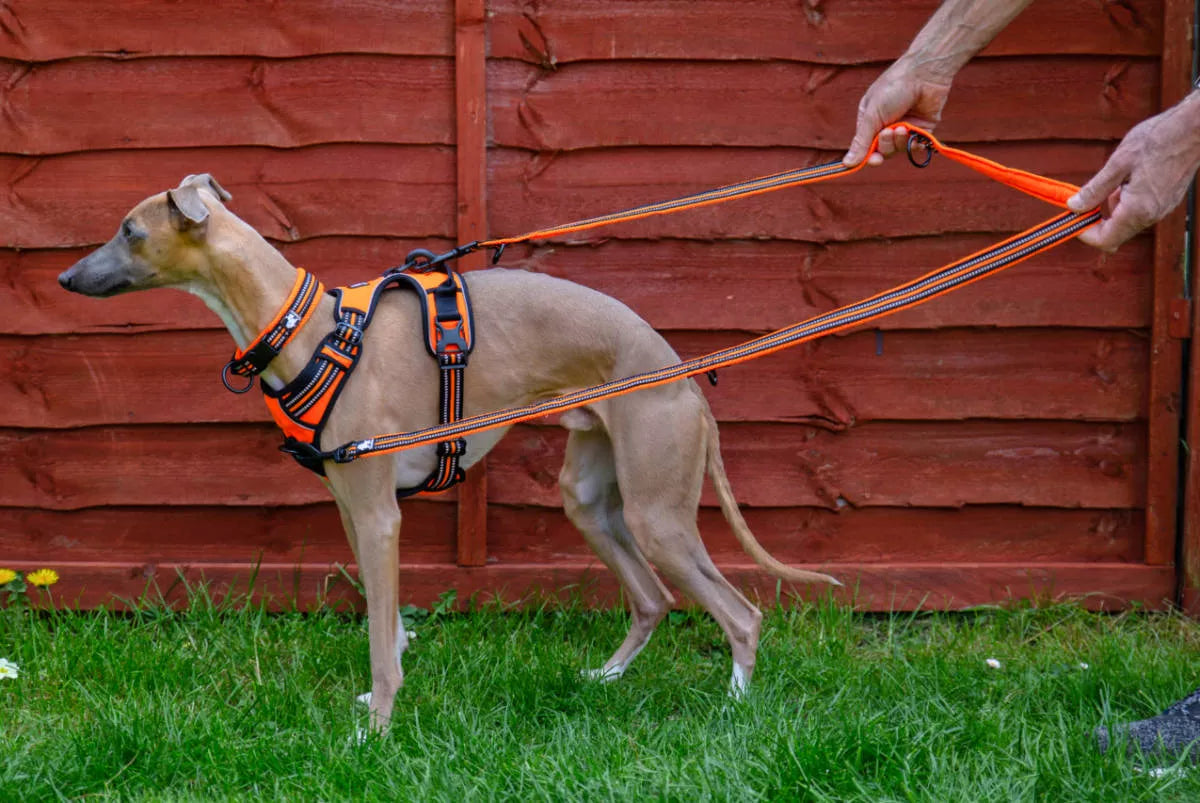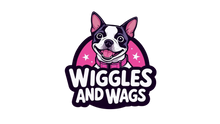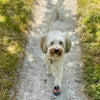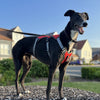No Pull Dog Harnesses - Unnatural, Or Great Walking Aid?

There are many types of no pull dog harnesses on the market today. Reports over the last few years have suggested that a few harness designs have the potential to negatively affect the natural gait of your dog as it walks. In extreme circumstances, this could hinder correct shoulder movement and could cause problems in later life.
Most of the harness designs available to consumers are of good quality and have been ergonomically designed to fit your dog well and be fit for purpose. In many cases, problems occur when a harness has been poorly fitted or it just doesn't suit your dog's size and shape.
Here we explore the characteristics of the no pull dog harness and look at the style, design and fit of different variations. At this stage, it is worth pointing out that the overall concept and walking action that is obtained by using a no pull harness should not cause your dog harm or distress in any way.
You should always have the attitude that a non pull harness should be used as a training aid to promote better walking behaviour. It should be handled with care and any forces applied to it (via a lead or double ended lead) should be subtle and not aggressive. If you are patient and calm, you have a much better chance of reaching your goal - to have a patient and calm dog walking by your side!
There are several designs and configurations to choose from here - all of which are designed to help the owner gain better control of the dog when walking. However, no pull harnesses are not a miracle cure and it will always require some input from you.
This level of input depends on how easy your dog is to train and how it responds to you. With this in mind, always try to engage with your dog before any training.
Remember that the ultimate goal is to get your dog to walk nicely by your side. A no pull harness is merely a tool to help you to get better control of your dog and should be fit for purpose for many years to come. When your dog walks well by your side, you can simply carry on using it as an everyday harness.

If you have a dog with a thick coat, this type of harness can provide support and the padding will be provided by the natural insulation and covering of fur.
Some designs will offer a strap that can cross over the shoulder area so it is very important to use any size guides and diagrams to ensure you buy the correct size and/or the style that is best suited for the size and breed of your dog.
If there is a danger of a strap coming in close contact with the main shoulder area on your dog, this may not be the best choice for you. Also if you have a dog that has very little fur, a strap only non pull harness may not provide the padding and comfort required for training and longer walks. However, a well fitted harness that does not impede the movement of the dog's shoulders or rear legs should provide a good base in which to train your dog.
In rare cases, this type of harness could also cause rubbing and pressure points, which can irritate the dog and provide a negative experience when out on walks. You should also bear in mind that straps can also become twisted around other straps so it is always a good idea to hang it up ready for the next use.

A lead can be attached to either clip, but most of the time a standard lead is clipped to the top clip only.
If you have a dog that does not pull on the lead, a top attachment should be all you need. However, if you have a dog that pulls hard you can use a no pull, easy walk device like this.
To aid training, you can use a double ended training lead. One end would attach to the front clip and the other end would attach to the top clip. What you then have is a braking (top clip) and steering (front clip) training aid to help stop pulling.
A padded harness may provide your dog with additional support and comfort as you walk with it. Some harnesses of this type also come with an elastic insert which can offer slight expansion when a dog moves or breathes in and out heavily. This short expanding strap is normally located on the under part of the harness around the belly and rib cage. This means that any pulling forces are cushioned and this should provide a comfortable experience for dog and owner.
With any type of no pull dog harness, it is always a good idea to properly align and position the middle rib cage strap. The strap that wraps around this area should not be too close to the dog's front legs.
As with many harnesses, if it is tight into the pit of the front legs this can cause some rubbing and irritation. Therefore, it is a good idea to choose the correct size that will bring this strap far enough back. This can often be achieved by looking at and comparing the available size guide with the measurements of your dog.
If your breed has a very long neck and deep chest then it might be better to go for the next size up, unless your measurement is closer to the minimum size of the harness. If you need to make any fine adjustments, you can also loosen the neck straps to bring it back a little on the dog's body. With this style of harness it is always better to go up a size if you are close to the maximum adjustment size shown on the website's size guide.
This style of harness is popular with many dog owners because it offers a more robust, padded option. This extra padding built-into the material could offer the best mix of practical style, function and good design.
Many owners report a comfortable walking experience with this design and they continue to be a popular choice with owners of many different breeds and size of dog.
Many harnesses of this type will offer a slightly longer harness plate on the dog's back, but the length of this plate does vary with the size of harness you choose.
The three strap design works especially well with long-bodied breeds like Whippets, Greyhounds and Lurchers. This is due to the fact that the rear strap often sits nicely at the bottom of the dog's rib cage.
Due to the location of the rear strap it is almost impossible for a dog to escape from a harness like this. To do so, it would have to get it's front paws and legs through the rear strap in some way and that would be a trick Houdini would be very proud of!
Many harnesses of this style will also include a front clip so a standard or double ended lead can be attached to it. The front and top clips can also be used with a running lead or bungee lead. Many runners will recommend this style, due to the fact that the harness sits a little further back on the dog and this can help with balance when running.
Also watch out for those that sit too high up on the neck area. The lower neck, upper chest and front rib cage area is a good combination to equal out any pulling forces. In all cases, you should have good freedom of movement and anything that restricts this movement around the mid and upper limb could have a detrimental effect on the dog's gait in the long-term.
To find out more about the variations of products available, view our range of dog harnesses here.
Most of the harness designs available to consumers are of good quality and have been ergonomically designed to fit your dog well and be fit for purpose. In many cases, problems occur when a harness has been poorly fitted or it just doesn't suit your dog's size and shape.
Here we explore the characteristics of the no pull dog harness and look at the style, design and fit of different variations. At this stage, it is worth pointing out that the overall concept and walking action that is obtained by using a no pull harness should not cause your dog harm or distress in any way.
You should always have the attitude that a non pull harness should be used as a training aid to promote better walking behaviour. It should be handled with care and any forces applied to it (via a lead or double ended lead) should be subtle and not aggressive. If you are patient and calm, you have a much better chance of reaching your goal - to have a patient and calm dog walking by your side!
Different types of no pull harnesses
There are several designs and configurations to choose from here - all of which are designed to help the owner gain better control of the dog when walking. However, no pull harnesses are not a miracle cure and it will always require some input from you.
This level of input depends on how easy your dog is to train and how it responds to you. With this in mind, always try to engage with your dog before any training.
Remember that the ultimate goal is to get your dog to walk nicely by your side. A no pull harness is merely a tool to help you to get better control of your dog and should be fit for purpose for many years to come. When your dog walks well by your side, you can simply carry on using it as an everyday harness.
Strap only style non pull harness
This design will usually consist of a strap that fixes around the girth (rib cage) and the neck and a horizontal strap across the chest. There are subtle variations of this design but in most cases the straps are located in similar positions across different ranges and designs.
If you have a dog with a thick coat, this type of harness can provide support and the padding will be provided by the natural insulation and covering of fur.
Some designs will offer a strap that can cross over the shoulder area so it is very important to use any size guides and diagrams to ensure you buy the correct size and/or the style that is best suited for the size and breed of your dog.
If there is a danger of a strap coming in close contact with the main shoulder area on your dog, this may not be the best choice for you. Also if you have a dog that has very little fur, a strap only non pull harness may not provide the padding and comfort required for training and longer walks. However, a well fitted harness that does not impede the movement of the dog's shoulders or rear legs should provide a good base in which to train your dog.
In rare cases, this type of harness could also cause rubbing and pressure points, which can irritate the dog and provide a negative experience when out on walks. You should also bear in mind that straps can also become twisted around other straps so it is always a good idea to hang it up ready for the next use.
Front clip easy walk harness with padding
A front clip harness is just another term used to describe a harness with a lead attachment point at the front. This is normally located on the dog's chest. Most harnesses of this design will also have a leash clip on the top of the harness, around the dog's upper back and at a central point.
A lead can be attached to either clip, but most of the time a standard lead is clipped to the top clip only.
If you have a dog that does not pull on the lead, a top attachment should be all you need. However, if you have a dog that pulls hard you can use a no pull, easy walk device like this.
To aid training, you can use a double ended training lead. One end would attach to the front clip and the other end would attach to the top clip. What you then have is a braking (top clip) and steering (front clip) training aid to help stop pulling.
A padded harness may provide your dog with additional support and comfort as you walk with it. Some harnesses of this type also come with an elastic insert which can offer slight expansion when a dog moves or breathes in and out heavily. This short expanding strap is normally located on the under part of the harness around the belly and rib cage. This means that any pulling forces are cushioned and this should provide a comfortable experience for dog and owner.
With any type of no pull dog harness, it is always a good idea to properly align and position the middle rib cage strap. The strap that wraps around this area should not be too close to the dog's front legs.
As with many harnesses, if it is tight into the pit of the front legs this can cause some rubbing and irritation. Therefore, it is a good idea to choose the correct size that will bring this strap far enough back. This can often be achieved by looking at and comparing the available size guide with the measurements of your dog.
If your breed has a very long neck and deep chest then it might be better to go for the next size up, unless your measurement is closer to the minimum size of the harness. If you need to make any fine adjustments, you can also loosen the neck straps to bring it back a little on the dog's body. With this style of harness it is always better to go up a size if you are close to the maximum adjustment size shown on the website's size guide.
This style of harness is popular with many dog owners because it offers a more robust, padded option. This extra padding built-into the material could offer the best mix of practical style, function and good design.
Many owners report a comfortable walking experience with this design and they continue to be a popular choice with owners of many different breeds and size of dog.
Three strap / no escape anti pull dog harness

This style is a real hit with runners and owners of breeds like whippets, Greyhounds, Lurchers, gun dogs and working dogs. It has a handy three-strap configuration which consists of:
- A strap at the front
- A strap around the mid rib cage and torso
- One strap further back around the lower back.
Many harnesses of this type will offer a slightly longer harness plate on the dog's back, but the length of this plate does vary with the size of harness you choose.
The three strap design works especially well with long-bodied breeds like Whippets, Greyhounds and Lurchers. This is due to the fact that the rear strap often sits nicely at the bottom of the dog's rib cage.
Due to the location of the rear strap it is almost impossible for a dog to escape from a harness like this. To do so, it would have to get it's front paws and legs through the rear strap in some way and that would be a trick Houdini would be very proud of!
Many harnesses of this style will also include a front clip so a standard or double ended lead can be attached to it. The front and top clips can also be used with a running lead or bungee lead. Many runners will recommend this style, due to the fact that the harness sits a little further back on the dog and this can help with balance when running.
Are there poorly designed harness?
It makes sense that there are some out there, but in our experience most dog harnesses are fit for purpose and will do the job well. However, there is a case to suggest that any harness that includes a horizontal strap which covers the top or mid shoulder area is not such a good thing.Also watch out for those that sit too high up on the neck area. The lower neck, upper chest and front rib cage area is a good combination to equal out any pulling forces. In all cases, you should have good freedom of movement and anything that restricts this movement around the mid and upper limb could have a detrimental effect on the dog's gait in the long-term.
In Conclusion
My opinion is based on the information available and also 15 years experience in caring for and training dogs. I believe that the design and concept of no pull dog harnesses are not cruel. I also feel that if fitted correctly, they should not give your dog any discomfort or cause long-term damage to your dog. However, it is always worth checking the design, size and configuration of a harness before making a decision to purchase. Following your research, if a harness of this type does not fit your dog correctly or is impeding how it walks or moves, then you should seek advice from the supplier of the product. A good, reputable dealer should be more than happy to help.To find out more about the variations of products available, view our range of dog harnesses here.





